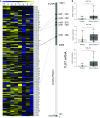Toll-like Receptor 7 Is Reduced in Severe Asthma and Linked to an Altered MicroRNA Profile
- PMID: 26815632
- PMCID: PMC4960627
- DOI: 10.1164/rccm.201502-0280OC
Toll-like Receptor 7 Is Reduced in Severe Asthma and Linked to an Altered MicroRNA Profile
Abstract
Rationale: Asthma is one of the most common chronic diseases worldwide, and individuals with severe asthma experience recurrent exacerbations. Exacerbations are predominantly viral associated and have been linked to defective airway IFN responses. Ascertaining the molecular mechanisms underlying this deficiency is a major research goal to identify new therapeutic targets.
Objectives: We investigated the hypothesis that reduced Toll-like receptor 7 (TLR7)-derived signaling drove the impaired IFN responses to rhinovirus by asthmatic alveolar macrophages (AMs); the molecular mechanisms underlying this deficiency were explored.
Methods: AMs were recovered from bronchoalveolar lavage from healthy subjects and patients with severe asthma. Expression of pattern-recognition receptors and microRNAs was evaluated by quantitative polymerase chain reaction and Western blotting. A TLR7-luciferase reporter construct was created to evaluate binding of microRNAs to the 3' untranslated region of TLR7. IFN production was measured by quantitative polymerase chain reaction and ELISA.
Measurements and main results: The expression of TLR7 was significantly reduced in severe asthma AMs and was associated with reduced rhinovirus and imiquimod-induced IFN responses by these cells compared with healthy AMs. Severe asthma AMs also expressed increased levels of three microRNAs, which we showed were able to directly reduce TLR7 expression. Ex vivo knockdown of these microRNAs restored TLR7 expression with concomitant augmentation of virus-induced IFN production.
Conclusions: In severe asthma, TLR7 deficiency drives impaired innate immune responses to virus by AMs. Blocking a group of microRNAs that are up-regulated in these cells can restore antiviral innate responses, providing a novel approach for therapy in asthma.
Keywords: alveolar macrophage; interferon; rhinovirus.
Figures






Comment in
-
IFN Deficiency in Asthma Attacks. Is Restoring Toll-like Receptor-7 Expression a New Treatment Approach in Severe Asthma?Am J Respir Crit Care Med. 2016 Jul 1;194(1):1-3. doi: 10.1164/rccm.201602-0223ED. Am J Respir Crit Care Med. 2016. PMID: 27367880 Free PMC article. No abstract available.
Similar articles
-
Rhinovirus 16-induced IFN-α and IFN-β are deficient in bronchoalveolar lavage cells in asthmatic patients.J Allergy Clin Immunol. 2012 Jun;129(6):1506-1514.e6. doi: 10.1016/j.jaci.2012.03.044. J Allergy Clin Immunol. 2012. PMID: 22657407
-
Toll-like receptor 7 governs interferon and inflammatory responses to rhinovirus and is suppressed by IL-5-induced lung eosinophilia.Thorax. 2015 Sep;70(9):854-61. doi: 10.1136/thoraxjnl-2014-205465. Epub 2015 Jun 24. Thorax. 2015. PMID: 26108570 Free PMC article.
-
Bronchial mucosal IFN-α/β and pattern recognition receptor expression in patients with experimental rhinovirus-induced asthma exacerbations.J Allergy Clin Immunol. 2019 Jan;143(1):114-125.e4. doi: 10.1016/j.jaci.2018.04.003. Epub 2018 Apr 24. J Allergy Clin Immunol. 2019. PMID: 29698627 Free PMC article. Clinical Trial.
-
Regulation and Function of Interferon-Lambda (IFNλ) and Its Receptor in Asthma.Front Immunol. 2021 Nov 10;12:731807. doi: 10.3389/fimmu.2021.731807. eCollection 2021. Front Immunol. 2021. PMID: 34899691 Free PMC article. Review.
-
The therapeutic potential of Toll-like receptor 7 stimulation in asthma.Inflamm Allergy Drug Targets. 2012 Dec;11(6):484-91. doi: 10.2174/187152812803589967. Inflamm Allergy Drug Targets. 2012. PMID: 23078048 Free PMC article. Review.
Cited by
-
Small RNA Species and microRNA Profiles are Altered in Severe Asthma Nanovesicles from Broncho Alveolar Lavage and Associate with Impaired Lung Function and Inflammation.Noncoding RNA. 2019 Nov 2;5(4):51. doi: 10.3390/ncrna5040051. Noncoding RNA. 2019. PMID: 31684064 Free PMC article.
-
Viral Infection and Airway Epithelial Immunity in Asthma.Int J Mol Sci. 2022 Aug 31;23(17):9914. doi: 10.3390/ijms23179914. Int J Mol Sci. 2022. PMID: 36077310 Free PMC article. Review.
-
Allergic Airway Disease Prevents Lethal Synergy of Influenza A Virus-Streptococcus pneumoniae Coinfection.mBio. 2019 Jul 2;10(4):e01335-19. doi: 10.1128/mBio.01335-19. mBio. 2019. PMID: 31266877 Free PMC article.
-
Childhood asthma heterogeneity at the era of precision medicine: Modulating the immune response or the microbiota for the management of asthma attack.Biochem Pharmacol. 2020 Sep;179:114046. doi: 10.1016/j.bcp.2020.114046. Epub 2020 May 22. Biochem Pharmacol. 2020. PMID: 32446884 Free PMC article. Review.
-
Mast cells are permissive for rhinovirus replication: potential implications for asthma exacerbations.Clin Exp Allergy. 2017 Mar;47(3):351-360. doi: 10.1111/cea.12879. Epub 2017 Jan 26. Clin Exp Allergy. 2017. PMID: 28008678 Free PMC article.
References
-
- Grissell TV, Powell H, Shafren DR, Boyle MJ, Hensley MJ, Jones PD, Whitehead BF, Gibson PG. Interleukin-10 gene expression in acute virus-induced asthma. Am J Respir Crit Care Med. 2005;172:433–439. - PubMed
-
- Wark PA, Johnston SL, Moric I, Simpson JL, Hensley MJ, Gibson PG. Neutrophil degranulation and cell lysis is associated with clinical severity in virus-induced asthma. Eur Respir J. 2002;19:68–75. - PubMed
-
- Godard P, Chanez P, Siraudin L, Nicoloyannis N, Duru G. Costs of asthma are correlated with severity: a 1-yr prospective study. Eur Respir J. 2002;19:61–67. - PubMed
Publication types
MeSH terms
Substances
Grants and funding
LinkOut - more resources
Full Text Sources
Other Literature Sources
Medical

